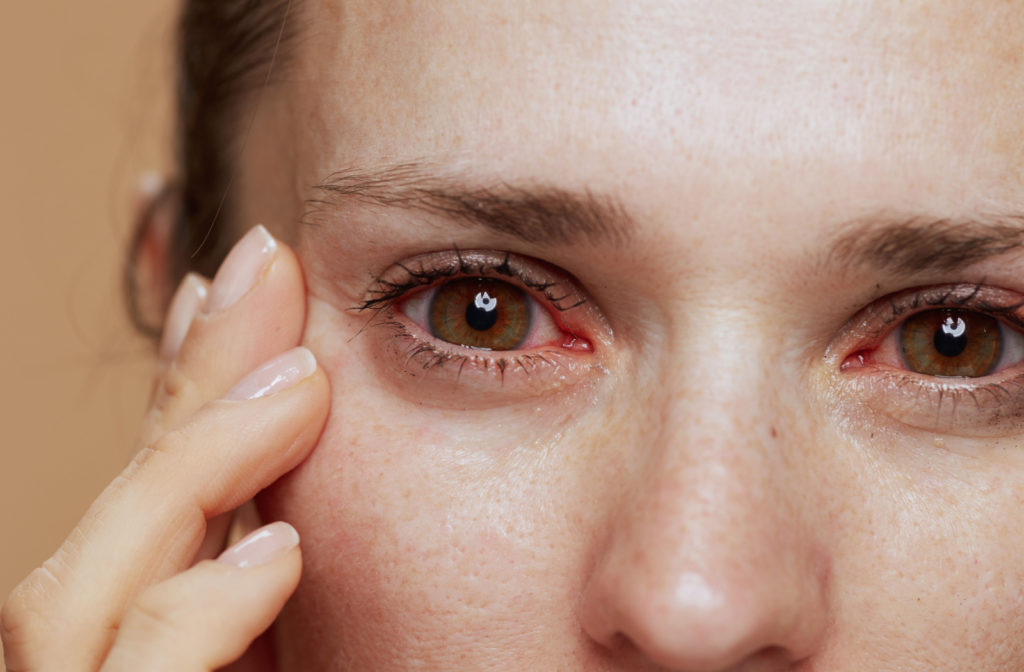Your child comes home from school with red, itchy eyes, and you start the familiar cycle of uncertainty. Is this just another allergy season, or could it be something more serious, like pink eye?
Pink eye and eye allergies are both types of conjunctivitis, so their symptoms can be uncomfortably similar and tough to distinguish. Noticing the subtle differences can be a bit like reading a foreign language, and your optometrist can help if you’re unsure, but identifying it quickly can alleviate your child’s discomfort and potentially prevent the spread of something infectious.
You can tell the difference between eye allergies and pink eye by considering symptoms, such as itchiness and discharge, and when they first appeared. Allergies tend to have a more direct trigger.
Identifying Eye Allergies
Eye allergies, or allergic conjunctivitis, result from your immune system overreacting to an allergen. The symptoms often include:
- Redness
- Itching
- Tearing, or a clear, watery discharge
- Swelling
Consider them like hay fever for your eyes, so you may also notice some sneezing. This condition is often seasonal, flaring up during high pollen counts.
Common Triggers & Risk Factors
Common culprits, apart from seasonal pollen, include:
- Pet dander
- Indoor and outdoor mold
- Dust mites and their waste
- Cigarette smoke and air pollution
Risk factors for developing eye allergies include a family history of allergies or a personal history of other allergic conditions, such as hay fever or eczema.
Identifying Pink Eye
When people think about pink eye, they typically think about viral or bacterial conjunctivitis. This is an inflammation of the thin, clear covering of the eye’s white part and inside the eyelids, called the conjunctiva. This may happen when a virus, such as a cold or flu virus, or bacteria get into your eye and infect it. Both of these types can be highly contagious.
The hallmark symptom is a pink or reddish tint to the white of the eye caused by dilated blood vessels. Other symptoms vary depending on the cause of the inflammation:
- Viral Pink Eye: Typically starts in one eye and might spread to the other, often accompanied by a watery discharge rather than a thick one. You also may notice cold or flu symptoms simultaneously.
- Bacterial Pink Eye: Usually affects both eyes with a heavy yellow or green discharge that could stick your eyelids together and can sometimes occur alongside an ear infection.
You can also get chemical conjunctivitis caused by irritants such as smoke, dust, fumes, or hazardous chemicals. Much like allergic conjunctivitis, the chemical type isn’t contagious. It can be an eye emergency, however, and should be treated as such.
Key Differences Between Eye Allergies & Pink Eye
Diagnosing eye allergies and pink eye at home requires looking closely at their symptoms and the factors surrounding them.
Eye allergies typically involve itching as a predominant symptom, and tear production slightly increases, causing watery eyes. Allergic reactions are rapid, with symptoms showing up almost immediately after exposure to allergens.
The infectious nature of pink eye leads to discharge and a burning feeling in the eyes. The discharge can cause the eyelids to stick together overnight. Unlike eye allergies, pink eye doesn’t always present with itching.
Generally, itching means eye allergies, and heavy discharge means pink eye.
If you’re still unsure, consider these questions:
- Onset: How quickly did symptoms develop? Allergies tend to be relatively sudden; infections can appear more gradually.
- Duration: How long have symptoms lasted? Allergies can fade once the allergen is removed, while pink eye can linger for weeks.
- Environment: Are there other allergy triggers around? A change in location or season may indicate allergies, whereas a recent illness could suggest pink eye.

Treatment & Management
Telling the difference between eye allergies and pink eye is only the first step. Next comes relief.
Treatment for Eye Allergies
For mild cases, over-the-counter antihistamines and decongestants can be very effective at reducing symptoms, while artificial tears can hydrate your eyes and wash away allergens. Your doctor may recommend allergy eye drops or corticosteroids for severe reactions.
Treatment for Pink Eye
Treatment for pink eye depends on the cause:
- Viral Pink Eye: Viral infections usually clear up on their own in 1–2 weeks. During this time, you should manage discomfort with clean, cool compresses and artificial tears.
- Bacterial Pink Eye: Bacterial symptoms can improve in as little as 2–5 days. Sometimes, your doctor may prescribe antibiotic eye drops or ointment if the symptoms are particularly severe or there’s a high chance of spreading to others.
Preventive Measures for Both Conditions
The best course of action is always prevention. For eye allergies:
- Identify your allergy trigger.
- Stay indoors on high pollen count days.
- Use allergen-proof covers on pillows and mattresses.
- Use air purifiers with HEPA filters.
- Wash hands and clothes frequently.
For pink eye, you’re taking steps not only to protect yourself but those around you
- Frequently wash your hands.
- Avoid touching or rubbing your eyes.
- Don’t share items like towels or eye makeup.
- Clean contacts thoroughly.
Protecting Your Child’s Visual Health
The importance of distinguishing between eye allergies and pink eye cannot be overstated. Knowing what you’re dealing with allows you to find the appropriate treatment swiftly, possibly easing symptoms and averting the spread of an infection.
If in doubt, always consult with a healthcare professional. Our Total Vision Tierrasanta team can perform tests if necessary and offer personalized advice on managing and preventing both eye allergies and pink eye. If someone in your family looks like they have conjunctivitis, book an eye exam.
Remember, the health of your eyes is nothing to sneeze—or rub—at.


